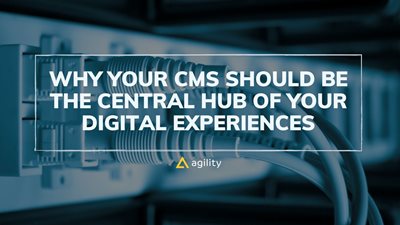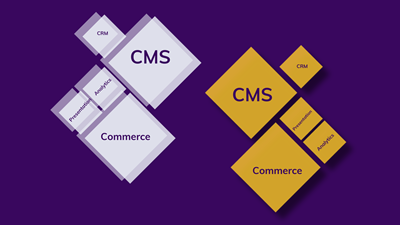Why Your CMS Should Be the Central Hub of Your Digital Experience
Take your digital strategy to the next level with a CMS powered content hub.


Providing a personalized experience for your web audiences is critical to grabbing and keeping their attention and converting more visitors into customers.
An integrated experience, or providing a uniform look and feel across all your digital channels, is also essential. You want your guests to feel comfortable no matter where they are engaged with your content. Integrating your systems will also be helpful for your team as they have fewer assets to manage.
Enterprise-level organizations often face the challenge of creating an enormous amount of content that caters to multiple audiences and gets distributed across several channels at a never-ending pace. Unfortunately, that content is often scattered in several places for many of these companies.
When the marketing team needs to update a campaign published in the last two years or reuse a piece of content for a different audience, it can be challenging to get started since no one knows where to find the original version. It becomes faster to recreate that content multiple times rather than spend countless hours searching for those lost content assets.
To solve this problem, businesses need a centralized location that houses all of their content assets, increases the visibility of what’s already available, and ensures that they can find it quickly when a team member is looking for that asset. According to Gartner, 60% of CMOs have used centralization to increase operational efficiency.
Enterprises need a content hub, and a headless CMS provides the perfect solution for building one.
When you make your content management system (CMS) the central hub of your digital experience, you will be able to give your audience what they are looking for while also making the job easier for you and your team.
What Is a Content Hub?

A content hub is a centralized location that houses all of your digital assets in one place. Instead of keeping all of your content scattered across multiple locations, a content hub makes it easier for marketing teams to find those content assets when they need them. An enterprise content hub provides a 360-degree view of all the content an organization has created, enabling marketing teams to streamline campaigns and move with speed and efficiency.
Why Use a Headless CMS?
Enterprises may consider a digital asset management (DAM) solution as a content hub because it already stores multiple assets. However, a content hub needs to do more than just a database for storing content assets; it also needs to enable organizations to orchestrate digital experiences across multiple channels, something a headless CMS does best.
Components of a Content Hub
Let’s look at the components that make up a content hub.

Headless CMS
The core component of a content hub should be a headless CMS. The decoupled architecture of this type of content management system doesn’t restrict enterprises to only managing content on one channel. Instead, they can use APIs to connect to different touchpoints, including mobile devices, digital signs, AR & VR devices, etc. Also, those APIs enable easier integrations with the other components of a content hub.
DAM Platform
The DAM solution is crucial for storing all of an enterprise’s content assets. To facilitate personalization and localization campaigns and cater to millions of customers, enterprises need to have a large volume of content on hand. A DAM provides a repository for storing and distributing those content assets.
Content Marketing Platform
A content marketing platform (CMP) enables marketing teams to plan and collaborate to streamline their marketing efforts from end to end. This includes creating content strategies, collaborating internally, and optimizing content publication across different channels.
Additional Marketing Technology Tools
While the other systems mentioned above represent the core components of a content hub, organizations may also include other martech tools like analytics, a CRM, and more to help augment the different parts of the content hub and improve decision making.
Benefits of a Content Hub

The benefits of a content hub extend far beyond a repository for storing content. Some others include:
1. Centralized Content Management
A content hub breaks down content silos that scatter content across multiple components. Instead, organizations can centralize their content management efforts and have complete visibility and control over all of their digital assets.
2. Time to Market
Since marketing teams no longer have to spend countless hours searching for resources located in multiple silos, they can get marketing campaigns launched faster, easily reuse assets for various campaigns and get ahead of their competitors by reacting quickly to changing market conditions and trends.
3. Improved Security
With content assets centrally located, enterprises can more easily secure one platform or a group of seamlessly connected platforms than handle an isolated system that includes content items they’re not sure about.
Implementing and managing security protocols within a single system is smoother and safer than trying to manage multiple users across multiple systems. Using a central hub will handle the connections to each system, acting as a secure gateway.
Without a centralized system, each person on your team has a login and password for each of your plans. The opportunity for errors and security breaches is everywhere. Plus, keeping track of who has access to what quickly becomes a logistical nightmare. Onboarding new employees are tedious, and removing former employees must be done carefully to ensure each entry point remains secure. A centralized system allows for a single login. Simple.
If a security breach were to happen, severing the connection to the affected area is a cinch and doesn't compromise the security or accessibility of the remaining regions. Everything else continues as normal as you repair the problem. Once the problem area is secure, bring it back online and reconnect it to your CMS to get back to work.
4. Happier Customers
The ultimate benefit of a content hub is an improved customer experience. Marketers can create tailored and personalized campaigns more efficiently and deliver an omnichannel experience across several touchpoints.
Using your CMS as a central hub is a perfect way to manage system integrations. It will allow you to quickly gain insight into customer behaviors no matter where they are in the buying process while also identifying significant trends across platforms. With this information, you can effortlessly push content out to all your digital channels and assets without starting from scratch every time.
The result is a unified look and feels for your audience wherever they engage with your company online. Your audience will enjoy personalized experiences quickly, and moving across channels and assets will be effortless.
Your entire team will also be more efficient as they waste less time logging into and out of multiple systems, learning various interfaces, and figuring out how to do a single task in several places using different tools. Uploading, downloading, and exporting content and data from multiple locations will be passed. Your security team will appreciate the simplicity, and managing upgrades and additions will be streamlined processes.
In other words, your team will be happier and more productive, and your customers will reap the rewards.
5. Simpler Integration
The easiest way to provide an integrated experience is to integrate your systems.
From your sales and lead tracking to email marketing systems to CRM, keeping track of how you interact with current and potential customers can get messy. Whenever you make a change in one place, there's an endless number of places to carry that change. With so much to manage, the probability of errors and omissions increases.
Adding new systems and channels individually usually requires building it from the ground up, making sure to keep it consistent with everything else. Digital marketing is in constant flux, and new services and channels are continually rolling out. Every time you want to add a new asset, you must take the time to integrate it with each of your existing systems. A centralized system means a single point of integration and automatic connection with the rest.
When your CMS is the hub of your communication channels, you'll have access to everything in one place, making it simpler than ever to create and track changes across the board. Adding in new systems is easier and more efficient, so your team has more time to focus on making customers happy!
6. Tracking Trends and Other Analytics
Speaking of happy customers, analyzing strategies across multiple systems is painstaking work. From finding comparable statistics within each one to analyzing a multi-platform campaign, identifying weak areas and effective messaging can only be done once you've compiled all the data and then put it together to make comparing meaningful.
Tracking individual behavior from the earliest stages of the buying process through retention is more accurate when observing from a single point of view. Identifying bottlenecks and roadblocks are crucial but often tricky when data from one system has to be compared.
When all your campaigns begin in your CMS, data from all your channels become accessible with a button. When you have centralized data collection and analysis tools, identifying the trends and behaviors necessary to provide personalized content becomes straightforward.
A central hub is not only a faster and easier way to access information but also to roll out personalized content. After all, what good is identifying trends if you cannot capitalize on them while still trendy?
Plus, the reports necessary to evaluate your campaigns' effectiveness will be more straightforward and accurate when the data is centralized. When it comes time to prove the ROI to the boss or the board, you'll spend less time compiling data and creating charts and more time talking about which areas aren't performing as expected and where to double down.
8. User Friendliness
Another major issue with managing multiple tools is the varying interfaces provided by each. Without a central hub, each team member has to be familiar with how each of these systems works and how to complete a simple task in multiple ways. This can be frustrating for users who know what they want to do but must first figure out how a particular system handles such a task.
When you use your CMS as a central hub, there is only one workflow to create and one set of tools to learn. From managing a product catalog to updating web pages, users must only take the time to learn one process. That means more consistency across every project and more time to maximize consumer interactions rather than fussing with tools.
When your team is confident and comfortable with the interface of your CMS, and when they are experts at the tools it provides, day-to-day tasks will be faster and more accessible, and major projects will be more organized and consistent.
Why You Should Build an Enterprise Content Hub With Agility CMS
Choosing a headless CMS as an enterprise content hub provides even more flexibility and benefits for organizations that need one. Agility CMS is a hybrid headless CMS built for marketers and developers, making it an optimal choice for a content hub. Here are a few reasons that Agility stands out from alternatives:
Marketer-friendly
Agility CMS provides the user-friendly authoring interface that marketers are accustomed to from working with a traditional CMS. But it also enables them to create, edit and publish content across multiple channels. A structured, content-first approach allows content marketers to extend, reuse, and repurpose content faster and easier. Also, intuitive page management and navigation enable content teams to get more done without relying on developer assistance.
API-first Connectivity
Agility CMS’s API-first approach makes integrating with other systems like a DAM or CMP much simpler. Without these integrations, organizations risk recreating the same silos that make managing content and multiple systems a challenge. With Agility CMS, developers also have the freedom and flexibility to choose the frameworks and languages that work best for a particular channel.
Future-Proof Architecture
The separated frontend and backend layers of a headless CMS like Agility simplify the updating process and ensure that organizations never have to re-platform when new systems that can enhance a content hub are launched. It also means that as new channels for delivering content arise, the CMS can easily allow content teams to publish content to them as well.
Workflows and Security
Collaboration is essential to a well-functioning content hub. Agility CMS provides built-in roles, access control, and workflows that enable content team members to work together so that marketing campaigns stay on track quickly.
Library of Pre-built Integrations
Another thing that separates Agility CMS from other potential content hub options is our library of pre-built integrations that speed up integrations and provide all the resources necessary to improve the digital customer experience. Agility CMS features integrations for Cloudinary, Salesforce, HubSpot, Google Translate, and more in our extensive marketplace.
Centralizing Content Management for The English Montreal School Board
Since the EMSB lacked a single source of truth for its content assets, it was difficult for individual teams to manage multiple sites without affecting everyone else using their previous legacy CMS solution. Content couldn’t be indexed, there was no flexibility for various users, and multi-site management was impossible.
However, by adopting Agility CMS as a content hub, content teams now have control over permissions and roles and have created a central location to manage omnichannel experiences. Read more about how Agility CMS became the content hub for EMSB in our case study.

About the Author
Joel is CTO at Agility. His first job, though, is as a father to 2 amazing humans.
Joining Agility in 2005, he has over 20 years of experience in software development and product management. He embraced cloud technology as a groundbreaking concept over a decade ago, and he continues to help customers adopt new technology with hybrid frameworks and the Jamstack. He holds a degree from The University of Guelph in English and Computer Science. He's led Agility CMS to many awards and accolades during his tenure such as being named the Best Cloud CMS by CMS Critic, as a leader on G2.com for Headless CMS, and a leader in Customer Experience on Gartner Peer Insights.
As CTO, Joel oversees the Product team, as well as working closely with the Growth and Customer Success teams. When he's not kicking butt with Agility, Joel coaches high-school football and directs musical theatre. Learn more about Joel HERE.




